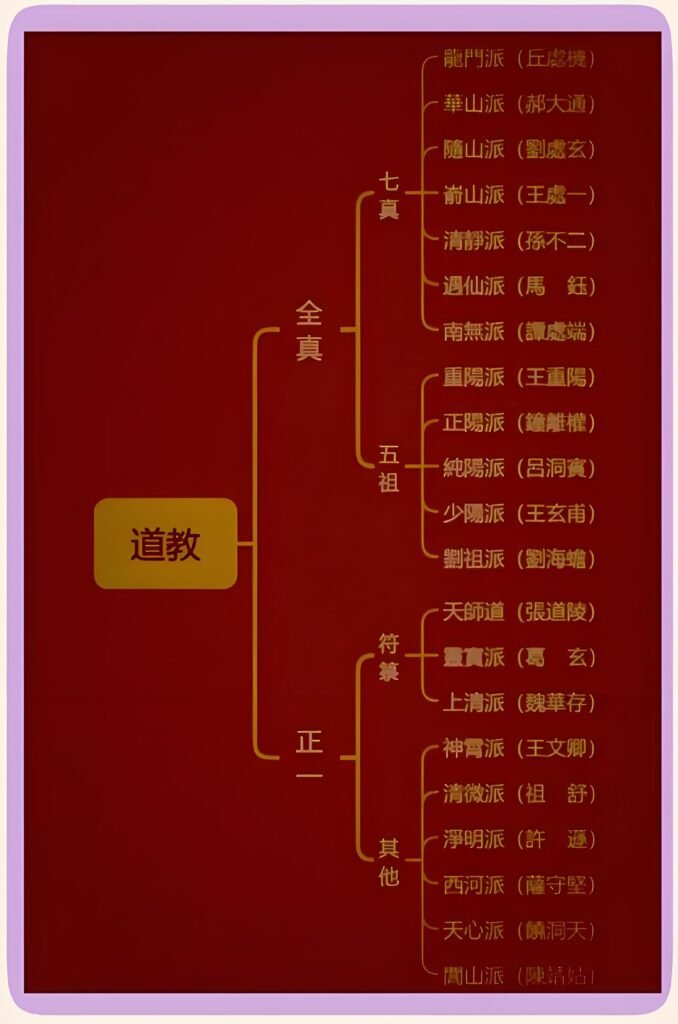The Dao Follows Nature, Rivers Flow to the Sea:
As China’s indigenous religion, Daoism has developed a pattern of “one origin, many streams” over two millennia. Different schools, shaped by distinct practices, regional cultures, and historical circumstances, present a rich and diverse tapestry, collectively forming a magnificent panorama of Daoist culture.

I. Two Pillars: The Millennia-Long Legacy of Zhengyi and Quanzhen
- Zhengyi Dao: Worldly Practice through Talismans and Rituals
Founded by Zhang Daoling at Heming Mountain during the Eastern Han Dynasty, the “Way of the Five Pecks of Rice” (Celestial Master Dao) established the first institutionalized Daoist tradition, with the Commentary on the Laozi as its theoretical foundation. This school centers on talismans (fu) for exorcism and ritual ceremonies (zhāijiào) and advocates engagement with the world:- The Celestial Master lineage at Dragon Tiger Mountain (Longhushan) has been passed down through 65 generations
- The Maoshan School (Shangqing tradition) emphasizes meditative visualization
- The Gezao School (Lingbao tradition) promotes universal salvation
During the Song-Yuan period, these three major talismanic traditions formally unified as “Zhengyi Dao,” later branching into movements like Shenxiao School (thunder rites) and Jingming Dao (loyalty and filial piety), forming the mainstream of southern Daoism.
- Quanzhen Dao: Transcendent Cultivation through Internal Alchemy
Founded by Wang Chongyang at Zhongnan Mountain during the Jin-Yuan transition, Quanzhen initiated a reformist wave in Daoism:- Internal alchemy (neidan) practice as the core, advocating “dual cultivation of inner nature (xing) and vital energy (ming)”
- Promoting the integration of Confucianism, Buddhism, and Daoism
- Strict adherence to monastic discipline (vegetarianism, temple residence, celibacy)
After disciple Qiu Chuji’s westward journey to meet Genghis Khan, his Longmen School became Quanzhen’s leading lineage. The earlier Southern Golden Elixir (Jindan) School (Zhang Boduan-Bai Yuchan lineage) later merged with Quanzhen, jointly shaping the internal alchemy system.
II. Constellations of Light: Regional Schools with Distinctive Features
- Classical Ancient Schools:
- Shangqing School: Originated with the female adept Wei Huacun (Eastern Jin), with the Yellow Court Canon establishing visualization techniques
- Lingbao School: Transmitted through the Ge Xuan-Ge Hong lineage; its ritual texts influenced later ceremonial traditions
- Taiyi School: Founded by Xiao Baozhen (Jin Dynasty), later absorbed into Zhengyi
- Folk Traditions:SchoolRegionDistinctive FeaturesLüshanFujian-TaiwanRed-Headed Masters; Nuo exorcismMeishanCentral HunanShaman-Dao fusion; ritual operaKunlunNorthwestIntegration of martial arts & alchemy
III. Rivers Merging into the Ocean: Modern Daoism’s Unified Landscape
1. Historical Integration
Yuan Dynasty imperial decree placed all Zhengyi branches under the leadership of the Celestial Master, unifying the three talismanic centers—Longhu, Maoshan, and Gezao mountains. After revitalization by Qiu Chuji, Quanzhen stood alongside Zhengyi as Daoism’s twin peaks during the Ming-Qing era.
2. Contemporary Transmission Systems
- Zhengyi Dao: Primarily non-monastic priests active in Jiangsu, Jiangxi, and Shanghai, preserving hereditary talismanic arts
- Quanzhen Dao: Centered on temple-based cultivation, with Beijing’s White Cloud Temple (Baiyun Guan) and Xi’an’s Chongyang Palace as key centers
- Hong Kong, Macau & Taiwan: Zhengyi rituals permeate folk culture; Taiwan’s spirit-writing shrines (Luantang) feature unique oracle practices
Conclusion: Diversity Within Unity
Though varied in practice, all Daoist schools share the core principles of “honoring the Dao and virtue” and “harmony between heaven and humanity.” Zhengyi connects with the cosmos through talismans, Quanzhen refines life through internal alchemy, and folk traditions weave faith into daily life—this unity in diversity embodies the enduring vitality of Daoism through the ages. Today, under the framework of the Chinese Taoist Association, these multifaceted traditions coexist harmoniously, their ancient wisdom continuing to nourish the spiritual lives of modern people.